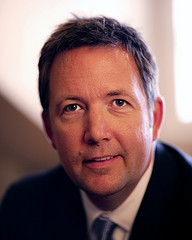 Steven VanRoekel is the government’s top IT guy, but in a way he’s also its chief content officer. VanRoekel was named chief information officer for the U.S. last fall, a job that oversees the everyday tech needs in federal offices while also looking at big picture issues, like increasing the government’s computing efficiency and web policy. It also involves managing, at least on a grand scale, the government’s push to releasing vast amounts of data on the web.
Steven VanRoekel is the government’s top IT guy, but in a way he’s also its chief content officer. VanRoekel was named chief information officer for the U.S. last fall, a job that oversees the everyday tech needs in federal offices while also looking at big picture issues, like increasing the government’s computing efficiency and web policy. It also involves managing, at least on a grand scale, the government’s push to releasing vast amounts of data on the web.
Journalists swoon at the thought of mountains of data to pore over, information rich with story possibilities. And yet in releasing raw data or structured APIs to the public, the government has shifted farther in the direction of publisher, a role journalists often like to keep to themselves.
VanRoekel was in Cambridge last week for events at Harvard, including a seminar at Harvard Law School where he spoke about advancing government transparency through data and technology. The centerpiece of the government’s tech transparency push has been Data.gov, the growing repository of federal datasets from departments within the executive branch. While VanRoekel is proud of the site, he said it needs to transform into a true open data platform, not just a spout people use to access government information.
“Not only can’t you see the needle in the haystack — you don’t see the haystack.”
“We have to get out of the data business and into the platform business,” he said.
What VanRoekel wants is for the government to be more than just a dumb pipe. Instead he envisions a system where the government provides a service for citizens and developers to experience data, either through widgets and apps, or through what they create on their own. The government would be the jumping-off point. VanRoekel sees it as moving away from a kind of distributed presentation of data to a more centralized distribution. That distinction is important, he said, because the sheer volume of datasets across various agencies can be daunting.
“Not only can’t you see the needle in the haystack — you don’t see the haystack,” he said. Another component would be the ability to track the usage and impact of the data, even using normal web analytics. That’s important, VanRoekel said, because effectiveness is just as important as openness.
VanRoekel is vocal in his support of open data and the use of APIs; during his time as managing director of the FCC, he once said “Everything should be an API.” So instead of offering up raw files for things like meat and poultry inspection records from the Department of Agriculture or Army suicide rates from the Department of Defense, the government would make it possible to find — and more importantly use — that data in more functional ways.
One result of the the new open initiatives on the federal level is that news outlets as well as independent developers have been taking advantage of that data either in reporting or consumer facing apps. In a post on the recent NICAR conference, Alex Howard summed up the work being done: “The parallels to what civic hackers are doing and what this community of data journalists [is] working on [are] unescapable. They’re focused on putting data to work for the public good, whether it’s in the public interest, for profit, in the service of civic utility or, in the biggest crossover, government accountability.”
Journalism, at least in this scenario, is as much about deciphering the unknown as it is about assembling a narrative from strings of bits and bytes. How does this dynamic change when the government wants to become a content platform? Governments and individual politicians have a long history of taking their message directly to the public, and that’s only increased thanks to the power of the web. VanRokel’s goal is an optimistic one that shares commonalities with journalism: The desire to use information to help people make sense of things. As bullish as he is on making Data.gov a true platform, the country’s CIO doesn’t think it will supplant or replace the builders who are providing content based on federal data. The things journalists and coders provide is a way of finding relationships in data that make it more applicable to the average person. That’s something the government isn’t good at yet, VanRoekel said. “Information never gets interesting unless you layer it on top of something,” VanRoekel said.
Still, there are many things on VanRoekel’s plate, and the open data question is just one. While he’s responsible for thinking about big picture ideas like open data, he also is the guy who oversees the government’s collection of printers, laptops, and BlackBerrys. That’s no small task. The government spends about $80 billion a year on technology, something VanRoekel likes to joke about: “I’ve got stuff sitting on the president’s desk and the International Space Station that comes out of that spending,” he said.